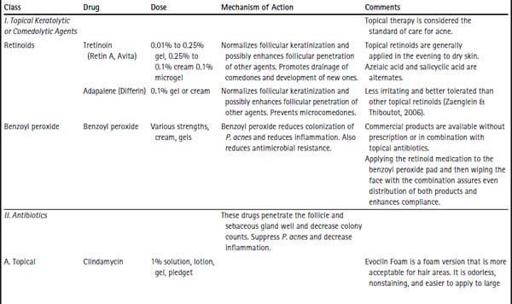Pediatric Primary Care Case Studies (125 page)
Read Pediatric Primary Care Case Studies Online
Authors: Catherine E. Burns,Beth Richardson,Cpnp Rn Dns Beth Richardson,Margaret Brady
Tags: #Medical, #Health Care Delivery, #Nursing, #Pediatric & Neonatal, #Pediatrics

Warn him that some mild irritation and drying may occur at the beginning of treatment, but this response should subside over time.
Advise him to:
- Avoid harsh cleansers and wash with mild soap and water morning and night.
- Use a noncomedogenic sunscreen to minimize sun exposure and photosensitivity and a noncomedogenic moisturizer if needed to combat dryness.
- Avoid over-the-counter acne products at the same time as the prescription ones are being used.
- Avoid oily pomades and keep his hair off his face.
- Avoid squeezing or manipulating the lesions because this will increase infection in the skin.
Assure Jose and his mother that most foods are not related to acne.
Tell him that his acne is not directly related to his wrestling contact with other students, but his ear guard may be a source of some acne lesions on his cheeks. Wrestling, however, can lead to other skin infections and he should watch for any other lesions that are different from the acne ones he currently has.
Table 31–1 Therapeutic Agents Used for Acne




Table 31–2 Outline of Care for Acne

When do you want to see this patient back again?
Generally you want to see new patients beginning acne management in about 6 weeks to assess response to medications and to support the patient as he takes on this new management regimen. You may need to increase the level of care, reduce it, or move to a maintenance program after initial success.
José and his mom seem to understand the regimen as explained and ask appropriate questions. You choose to get a translator for your discussion with the mother so that José is not expected to fulfill that role. You also hand him the prescriptions to give a nonverbal gesture of your trust in him as the primary manager of his condition and his ability to make decisions.
When he returns in 6 weeks, his face and chest have only 15 papules and pustules but there are still many comedones. You congratulate him on his care of his condition and he seems pleased with the progress, although he doesn’t like the dryness of his skin and he didn’t like the emergence of so many pustules during the first few weeks of the treatment. He does not have more lesions on his cheeks where the ear guards were in place. You elect to continue the treatment for another 6 weeks and then reassess his progress.
Key Points from the Case
1. Guidelines simplify the care of acne. They are based on the severity of the condition.
2. Treatment of acne in a teen requires understanding physiology, activities, cognitive development and experience, and the role of provider as advisor, not director, for care.
3. Activities such as sports or after-school work could influence the development and severity of conditions such as acne and need to be considered in assessment and planning for care.
4. Treatment of acne can be influenced by cultural beliefs and practices as with any healthcare problem. Awareness and openness to other approaches to management is helpful.
REFERENCES
Cohen, B. A. (2005). Disorders of the hair and nails. In B. A. Cohen (Ed.),
Pediatric
dermatology
(pp. 201–235). Philadelphia: Elsevier Mosby.
Gollnick, H. (2003). Current concepts of the pathogenesis of acne: implications for drug treatment.
Drugs, 63
, 1579–1596.
Guarnero, P. A. (2005). Mexicans. In J. G. Lipson & S. L. Dibble (Eds.),
Cultural and
clinical care
(pp. 330–342). San Francisco: UCSF Nursing Press.
